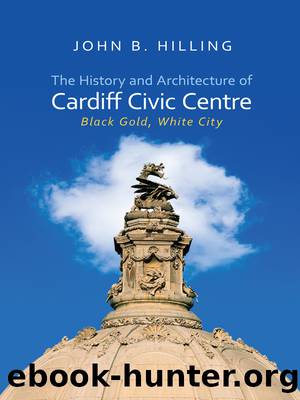The History and Architecture of Cardiff Civic Centre by Hilling John B.;

Author:Hilling, John B.;
Language: eng
Format: epub
Publisher: University of Wales Press
Pl. 25. Queen Alexandra Gardens. Seen from the air the formal layout of the Gardens is very clear. The Welsh National War Memorial, although not originally planned for this site, provides an eye-catching feature at the centre.
© Crown copyright: RCAHMW.
After the memorialâs completion, the designer (Sir J. Ninian Comper) was asked by the Parks Committee for his views on its setting. His answer was that he considered the general setting to be appropriate, but âsuggested beds of deep red china roses around the outside of the path circling the memorialâ and also that the acacias lining the approach footpaths be âreplaced with trees of a more columnar shape, such as cypressesâ.22 The changes were approved and the paths were accordingly lined with cherry trees and lawson cypresses. During the time since the Second World War the Gardens have become something of a sanctuary for commemorative memorabilia: in addition to the National War Memorial and the nineteenth-century statue of the first Lord Aberdare, five other memorials (including two for the Falklands Islands Conflict) have been erected there between 1983 and 2007.
The ornamental garden south of the National Museum, named the Gorsedd Gardens after the ring of standing stones â the Gorsedd Circle â re-erected there in 1905 (see Chapter 8), was initiated during the autumn of 1905 when the area was handed over to the Parks Department for development and maintenance.23 Development continued during the following year, but the opening to the public was delayed until July 1910, owing to the high cost of maintenance.24 The Gardens, sometimes referred to in its early years as the Druidical Gardens, are laid out with winding paths radiating from the circle of stones, and informal lawns, specimen trees and shrub borders (Pl. 26). The northern side has a yew hedge and iron railings backed by a row of cherry trees. The eastern side is bounded by an earthen bank, a leftover from the original enclosure of Cathays Park, with lime trees growing along the bank and pines at the north-east and south-east corners.25 Part of this bank was cut through in 2004 when a new access was formed to the gardens from Park Place. Within the Gardens are statues of David Lloyd George, politician, Lord Ninian Crichton-Stuart, soldier, and John Cory, coal owner and philanthropist. There is also a wooden, chalet-type hut of panelled construction, now used as a refreshment bar. Although of unknown date, it has been listed Grade II for its group value, and may be one of the caretakerâs shelters referred to in a 1938 âInventory of Park Buildings and Equipmentâ.
The City Hall Lawn began as a Green Circle and was originally separated from the Gorsedd Gardens by a road. By 1912 the circular lawn had become fenced with granite posts and heavy chains26 that, seeming to represent the spokes of a wheel, later became the ideal place for a plaque to the memory of the First World War 2/7th (Cyclists) Battalion of the Welch Regiment (later refixed to a pillar in front of the City Hall).
Download
This site does not store any files on its server. We only index and link to content provided by other sites. Please contact the content providers to delete copyright contents if any and email us, we'll remove relevant links or contents immediately.
Aircraft Design of WWII: A Sketchbook by Lockheed Aircraft Corporation(32218)
The Great Music City by Andrea Baker(31530)
Call Me by Your Name by André Aciman(20378)
The Secret History by Donna Tartt(18859)
The Art of Boudoir Photography: How to Create Stunning Photographs of Women by Christa Meola(18545)
Shoot Sexy by Ryan Armbrust(17661)
Plagued by Fire by Paul Hendrickson(17335)
Portrait Mastery in Black & White: Learn the Signature Style of a Legendary Photographer by Tim Kelly(16956)
Adobe Camera Raw For Digital Photographers Only by Rob Sheppard(16907)
Photographically Speaking: A Deeper Look at Creating Stronger Images (Eva Spring's Library) by David duChemin(16623)
Ready Player One by Cline Ernest(14531)
Pimp by Iceberg Slim(14398)
Bombshells: Glamour Girls of a Lifetime by Sullivan Steve(13978)
The Goal (Off-Campus #4) by Elle Kennedy(13544)
Art Nude Photography Explained: How to Photograph and Understand Great Art Nude Images by Simon Walden(12977)
Kathy Andrews Collection by Kathy Andrews(11737)
The Priory of the Orange Tree by Samantha Shannon(8893)
The remains of the day by Kazuo Ishiguro(8829)
Thirteen Reasons Why by Jay Asher(8800)
